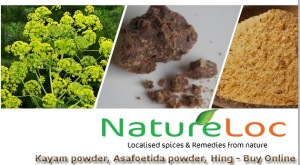Kayam – asafoetida – hing – A common culinary herb for flavouring
Asafoetida – kayam hing – A tempting spice and trusted medicinal herb (Ferula assafoetida L)
Asafoetida (Heeng) kayam Ferula assafoetida L. is a monoecious, herbaceous, perennial plant and one of the most important among the thirty species of Ferul. It is a well known medicine and condiment of India and tempting spice and trusted medicinal herb. (Heeng) kayam Asafoetida, also known as hing, is extracted from the stems of these giant perennial plants that grow wild in Central Asia, especially Northern Iran and Afghanistan. Asafoetida, the gum resin prized as a condiment in India and Iran, is obtained chiefly from plant Ferula Asafoetida. The Latin name ferula means “carrier”or “vehicle”. Asa is a latinized form of Farsi asa “resin”, and Latin foetidus means “smelling, fetid”.
What is Asafoetida (Heeng) kayam ?
Asafoetida (Heeng) kayam Ferula assafoetida L is the dried latex taken from the tap root of the plants belonging to Ferula species. The resin taken from the roots of these plants solidifies into a pungent spice. As per the name suggests, the spice has a fetid smell and has a bitter flavour. Once added to cooked recipes, it gives away a smooth flavour reminiscent of leeks. It is typically used in Indian cuisine as a flavour enhancer along with turmeric powder, particularly in lentil curries such as dal and other vegetable dishes. It is considered to be good for some of the common ailments like breathing problems including ongoing bronchitis and asthma. It is known by different names like ‘Hing’ in Hindi, ‘Hin’ in Bengali, ‘Ingu’ in Kannada, ‘Inguva’ in Telugu and ‘Perumkayam’ in Tamil
What is hing used for? Asafoetida-Kayam Spice for Indian Cusine
Kayam “Food of the Gods”Asafoetida (Heeng)
Asafoetida is stated to possess carminative, antispasmodic and expectorant properties . It has been used
for chronic bronchitis, pertussis, laryngismus stridulus, hysteria and specifically for intestinal flatulent colic Asafoetida is in use from ancient times in Indian medicine and cookery as a spice. Asafoetida is in use from ancient times in Indian medicine and cookery as a spice. It is also used in folk phytomedicine since antiquity in traditional medicine for the treatment of several neurological (epilepsy, paralysis, hysterias and depression), gastrointestinal (intestinal parasites, flatulence, weak digestion, stomach ache), respiratory (influenza, asthma), and reproductive disorders (premature labour, unusually painful, difficult and excessive menstruation, leucorrhoea, and infertility)
Various uses of the oleo-resin Kayam Asafoetida
Asafoetida is also excellent for settling flatulence and is prescribed by Indian herbalists for respiratory problems like whooping cough and asthma. The main use of Asafoetida is as a flavoring condiment. Kayam is used as a tenderizer and preservative for meat was known centuries ago. This herb or spice is used as a digestive aid,in pickling and in food as a condiment. In Indian cuisine, kayam typically works as flavour enhancer and used along with turmeric,specially in lentil curries,dal curries and in various vegetable curries and dishes. This spice is added to the food at the time of tempering or sometimes dried and powdered kayam an be mixed with salt and eaten with salads






















